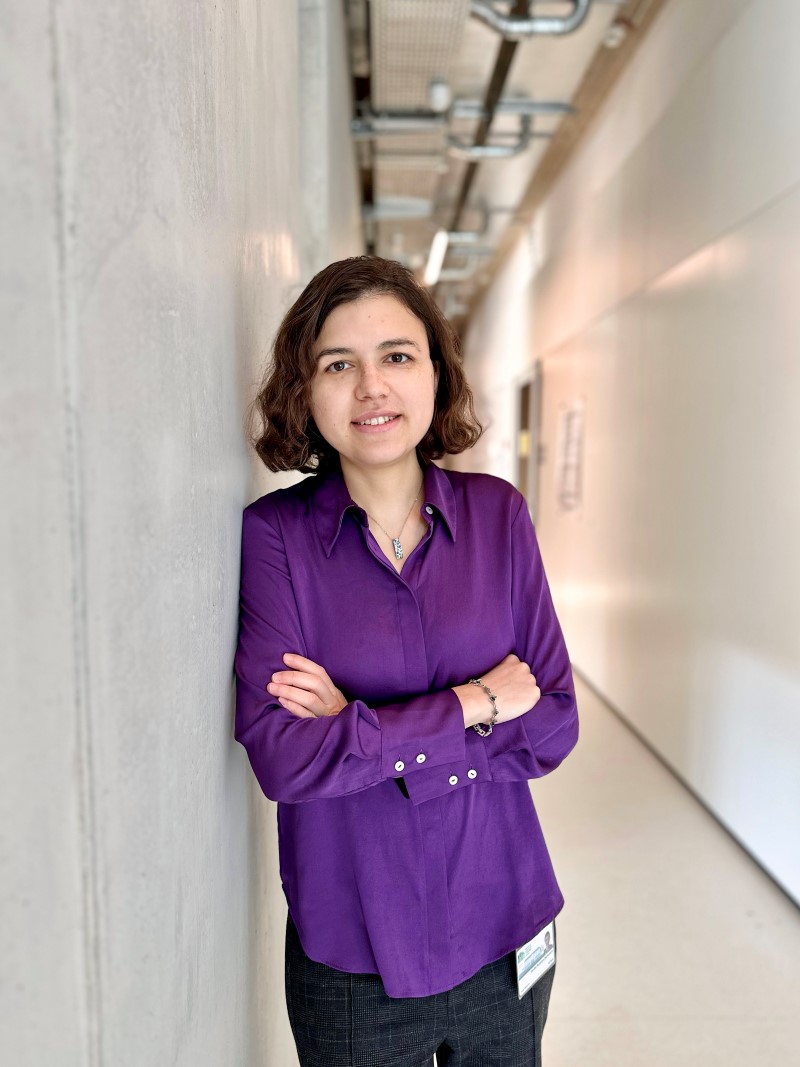April 9, 2024
The (Un)Reachable States of Matter
New assistant professor at ISTA bridges ultrafast physics and quantum mechanics
Ultrafast laser spectroscopy specialist Denitsa Baykusheva is one of the newest additions to the faculty at the Institute of Science and Technology Austria (ISTA) in 2024. By establishing the technology to examine the interaction between light and matter from a fully quantum perspective, she seeks to bridge the gap between ultrafast physics and quantum mechanics. As she pushes the boundaries of disciplines, Baykusheva’s work will find applications in developing new materials and ultrafast electronics.

A coffee chat with Denitsa Baykusheva on a busy Friday morning. As one of the newest faculty members to have joined the Institute of Science and Technology Austria (ISTA) this January, she is eager to share her ideas and plans. True to ISTA’s interdisciplinary mission, Baykusheva is conducting research at the intersection of physics, physical chemistry, and material science. Her graduate studies at ETH Zurich and postdoctoral research stays at Stanford PULSE Institute for Ultrafast Energy Science and Harvard University have led her to specialize in studying the interaction between light and matter mediated by ultrashort intense laser fields. “My research group at ISTA aims to bring the fields of ultrafast physics and quantum mechanics closer to one another,” says Baykusheva.
Light and matter: Putting quantum mechanics on both sides of the interaction
Often dubbed “the glue of matter,” electrons are intrinsically quantum entities at the microscopic level. In certain solids, the electrons’ quantum properties extend their influence beyond the minuscule scales of the quantum world and lead to interesting large-scale collective behaviors such as superconductivity or quantum magnetism. Such materials, known for their strong electron correlations, are often called “quantum materials.” The exotic physical properties of quantum materials make them particularly useful in research, but also in wide-ranging areas such as electronics, photonics, energy storage, and information technology.
For much of the previous century, physicists have used external stimuli like pressure, or electric and magnetic fields to create and tune new states of matter. “In recent years, ultrashort intense laser fields have allowed us to discover new properties of quantum materials by stabilizing transient states of matter away from equilibrium,” says Baykusheva. But so far, ultrafast light-matter interactions have not been examined from a fully quantum perspective. Instead, the principles of quantum mechanics have only been applied to one side of the interaction–the matter part–whereas light continued to be perceived as a classical electromagnetic field. Thus, this perspective is called “semiclassical”.
Toward new materials for ultrafast electronics
The semiclassical perspective mainly concentrates on average light intensities. However, photon numbers can exhibit characteristic fluctuations, even in the vacuum, Baykusheva explains. By analyzing the fluctuation statistics of light in light-matter interactions, she seeks to uncover how material properties fluctuate intrinsically. This information is critical to understanding both thermal and quantum phase transitions in the materials. “How the strong correlations among electrons in systems like superconductors get imprinted onto the quantum properties of light–and vice versa–remains largely uncharted territory,” adds Baykusheva.
Baykusheva’s work will find applications in developing new materials with new properties: “The overarching goal of my research group will be to bring ultrafast spectroscopy fully to the quantum regime. Understanding this gap is crucial for a deeper insight into the formation of ordered macroscopic phases and will allow us to create new phases of matter.” In addition, her research could further push the development of ultrafast electronics, one of the promising technologies for the digital future.
High-tech lab spaces to answer questions that “matter”
To achieve her aims, Baykusheva is equipping two dedicated lab spaces with cutting-edge technologies to tackle two complementary aspects of her research: time resolution, and spatial resolution. “As an experimental research group that will rely on minute measurements using advanced ultrafast optics, one very important factor for my lab is ensuring stable environmental conditions, such as the temperature and level of humidity,” says Baykusheva. This is necessary to achieve control over matter at extremely brief time scales and minuscule distances. “One of our labs will be equipped with a laser system emitting photons at 800 nanometers, which is at the edge of the visible and the near-infrared,” explains Baykusheva.
“However, to address the collective excitations that underlie complex behaviors at the macroscale, we need to convert these light pulses to the mid-infrared to terahertz region of the spectrum. At these frequencies, the laser beams are invisible to the bare eye, so we will build our own setups to generate and detect them, as well as to manipulate their photon states.” This technology will allow Baykusheva to drive materials out of equilibrium and then interrogate their atomic and subatomic properties at their natural timescales. “The ultimate goal is to explore states of matter unreachable under equilibrium conditions.”
These experiments examine the properties of matter on a scale of several tens to hundreds of micrometers, comparable to the size of a typical cloud fog droplet. However, this focus spot is far too large to allow studying local quantum properties at high spatial resolution. “In the second lab, we will develop tools to overcome the diffraction limit and study long-range correlations in solids, including entanglement, directly in real space,” explains Baykusheva.
Research at the boundary of what is possible
Being able to conduct independent research at the intersection of multiple disciplines is what brought the native Bulgarian to ISTA. “The level of independence and technical support I receive at ISTA, as well as the solid representation of quantum physics in the campus community, are such that there are very few places like ISTA,” she says. “Not to mention the 2022 Nobel Prize in Physics awarded to the quantum physicist Anton Zeilinger–Austria has a vibrant quantum community ranging from ISTA to various universities.” Apart from establishing collaborations in Austria, her focus now lies on building a team. “I envision up to ten highly motivated students and postdocs who are willing to take risks and perform very demanding research at the boundary of what is possible.”



